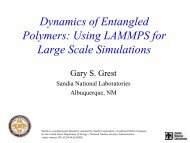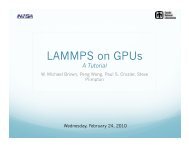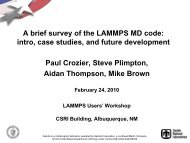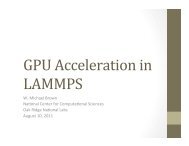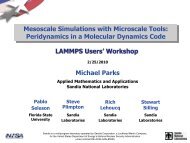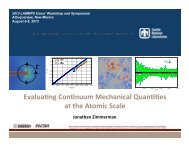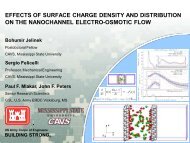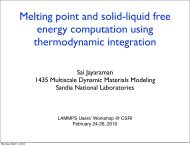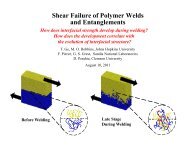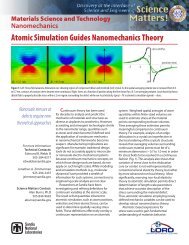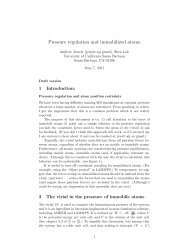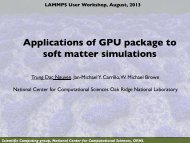Interatomic PotenRals in LAMMPS Aidan P. Thompson Sandia Na ...
Interatomic PotenRals in LAMMPS Aidan P. Thompson Sandia Na ...
Interatomic PotenRals in LAMMPS Aidan P. Thompson Sandia Na ...
Create successful ePaper yourself
Turn your PDF publications into a flip-book with our unique Google optimized e-Paper software.
<strong>Interatomic</strong> Poten-als <strong>in</strong> <strong>LAMMPS</strong> <br />
<strong>Aidan</strong> P. <strong>Thompson</strong> <br />
<strong>Sandia</strong> <strong>Na</strong>1onal Laboratories <br />
2 nd <strong>LAMMPS</strong> Users Workshop <br />
August 2011, Albuquerque, New Mexico <br />
<strong>Sandia</strong> is a multiprogram laboratory operated by <strong>Sandia</strong> Corporation, a Lockheed Mart<strong>in</strong> Company,<br />
for the United States Department of Energys <strong>Na</strong>tional Nuclear Security Adm<strong>in</strong>istration<br />
under contract DE-AC04-94AL85000."
Recently Added Poten-als <br />
• COMB poten-al (Genera-on 2) <br />
Tzu-‐Ray Shan (U Florida), talk on Tues PM metal and <br />
semiconductors and their oxides <br />
• Embedded ion method poten-als (EIM) <br />
Xiaowang Zhou (<strong>Sandia</strong>), ionic compounds combo of Li, <br />
<strong>Na</strong>, K, Rb, Cs, F, Cl, Br, and I <br />
• C++ version of ReaxFF <br />
Me1n Aktulga (LBNL), talk on Wed PM can be faster <br />
than Fortran version by 2-‐3x <br />
• Electron force field (eFF) <br />
Andres Jaramillo (Caltech), explicit electron dynamics <strong>in</strong> <br />
extreme condi1ons
Recently Added Poten-als <br />
• AIREBO poten-al bug fixes <br />
Marcel Fallet & Steve Stuart (Clemson), one more bug-fix,<br />
upgrade is imm<strong>in</strong>ent <br />
• Mish<strong>in</strong> ADP poten-al <br />
Chris We<strong>in</strong>berger (<strong>Sandia</strong>) & Chandra Veer S<strong>in</strong>gh <br />
(Cornell) angular-‐dependent EAM for metals and alloys <br />
• Dreid<strong>in</strong>g poten-al <br />
Tod Pascal (Caltech) hydrogen bond<strong>in</strong>g for solvated bio-molecules<br />
<br />
• New Peridynamics poten-als <br />
Mike Parks & Stuart Sill<strong>in</strong>g (<strong>Sandia</strong>), talk on Wed PM <br />
fracture at the meso and con1nuum scales
Upcom<strong>in</strong>g Poten-als <br />
• Core/shell poten-al <br />
Mike Chandross (<strong>Sandia</strong>), zero-‐order model for polariza1on, <br />
uranium and other nuclear fuel materials <br />
• COMB poten-al (Genera-on 3) <br />
Tzu-‐Ray Shan (U Florida), more materials with polariza1on <br />
effects <br />
• MGPT poten-al <br />
from John Moriarty & Jaime Marian (LLNL), tantalum and <br />
other transi1on metals <br />
• BOP poten-al <br />
Xiaowang Zhou and Don Ward (<strong>Sandia</strong>) High-‐accuracy <br />
poten1al for semiconductors
<strong>LAMMPS</strong> Poten-al benchmarks
Compute Cost of <strong>Interatomic</strong> Poten-als <br />
Grow<strong>in</strong>g Exponen-ally <br />
Compute cost of <strong>LAMMPS</strong> poten1als <br />
versus publica1on date <br />
Cost [core-sec/atom-timestep]<br />
10 -2<br />
10 -3<br />
10 -4<br />
10 -5<br />
10 -6<br />
MEAM<br />
CHARMm<br />
Still<strong>in</strong>ger-Weber<br />
EAM<br />
Tersoff<br />
EIM<br />
ReaxFF<br />
ReaxFF/C<br />
AIREBO<br />
h`p://lammps.sandia.gov/bench.html#poten1als <br />
eFF<br />
COMB<br />
GAP<br />
(Estim.)<br />
1980 1990 2000 2010<br />
Year Published<br />
Drivers <br />
• Cycles are cheap <br />
• Availability of quantum <br />
calcula1ons (N < 100) <br />
• Qualita1ve accuracy no longer <br />
enough
Challenges with Complex Poten-als <br />
• How to Implement <strong>in</strong> <strong>LAMMPS</strong>? <br />
– Rewrite code from scratch (REBO) <br />
– Integrate exis1ng serial code (ReaxFF) <br />
– Access via general API (KIM) <br />
• How to Validate <strong>LAMMPS</strong> Version? <br />
• How to Handle New Versions?
How to Fit Poten-als to New Materials? <br />
• Automated fieng procedures exist for certa<strong>in</strong> classes of <br />
materials and poten1als (EAM) <br />
• More commonly, good fits can be obta<strong>in</strong>ed only by gurus <br />
(Baskes, van Du<strong>in</strong>) <br />
• Comb<strong>in</strong>a1on of nonl<strong>in</strong>ear op1miza1on and physical <strong>in</strong>tui1on <br />
• Increas<strong>in</strong>g <strong>in</strong>terest <strong>in</strong> automated mach<strong>in</strong>e-‐learn<strong>in</strong>g <br />
approaches <br />
– Spl<strong>in</strong>es <br />
– Gene1c programs <br />
– Mul1-‐objec1ve op1miza1on <br />
– Neural networks <br />
– Series expansions
GAP Approach for <strong>Interatomic</strong> Poten-als <br />
GAP: A systema-c, <strong>in</strong>forma-cs approach <br />
• Based on QM and mathema1cs rather than <br />
empiricism. <br />
• Local density around each atom expanded <strong>in</strong> <br />
4D hyperspherical harmonics, analogous to <br />
Fourier series <br />
• Atomic configura1ons described by <br />
bispectrum of lowest-‐order coefficients <strong>in</strong> <br />
series <br />
• Preserves universal physical symmetries: <br />
<strong>in</strong>variance w.r.t. rota1on, transla1on, <br />
permuta1on <br />
• Gaussian process (GP) regression used to <br />
<strong>in</strong>terpolate energy of QM configura1ons <br />
• 100-‐1000x more expensive than MEAM <br />
• Far cheaper than QM, l<strong>in</strong>ear scal<strong>in</strong>g <br />
• Can trade performance and accuracy <br />
r<br />
r cut<br />
( ) = c j !<br />
! r<br />
j=0 m !,m=" j<br />
m ,m Y j !<br />
( )<br />
m ,m<br />
",#,$<br />
Diamond: Force errors for GAP fi`ed to DFT. <br />
Add<strong>in</strong>g higher-‐order GAP coefficients <br />
systema1cally <strong>in</strong>creases accuracy <br />
Bartok et al., PRL 104 136403 (2010) <br />
$<br />
#<br />
j<br />
#
GAP Poten-al for Beryllium <br />
Beryllium <br />
Work<strong>in</strong>g with GAP developers, fieng directly <br />
to forces and energies from high-‐temperature <br />
DFT MD simula1ons of small systems (from <br />
Mike Desjarlais, 1640) <br />
GAP Forces versus DFT Forces for <br />
Liquid Be at 5,000 K, 250 atoms <br />
!"<br />
#$<br />
#"<br />
$<br />
"<br />
Temperature [K]<br />
6000<br />
5000<br />
4000<br />
3000<br />
2000<br />
Temperature [K]<br />
6000<br />
5000<br />
4000<br />
3000<br />
2000<br />
1000<br />
Dr09 a-axis<br />
Ba09i a-axis<br />
DFT<br />
DFT Melt L<strong>in</strong>e<br />
EOS Benedict et al.<br />
Dr09 a-axis<br />
Ba09i a-axis<br />
DFT<br />
0 DFT Melt L<strong>in</strong>e<br />
0 EOS 50 Benedict et 100 al. 150 200 250 300<br />
P zz<br />
[GPa]<br />
!$<br />
!#"<br />
!#$<br />
!!" !#$ !#" !$ " $ #" #$ !"<br />
• Ini1al fit to: <br />
− ambient HCP <br />
− high-‐pressure BCC and liquid <br />
• Accurately reproduced that data <br />
• Problems with: <br />
− ambient elas1c constants <br />
− high-‐pressure HCP <br />
• Need to refit with more data



